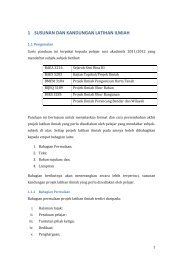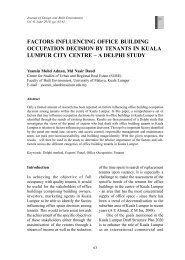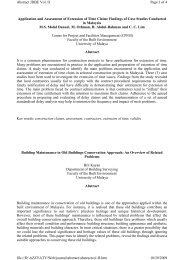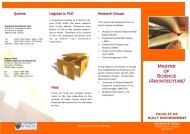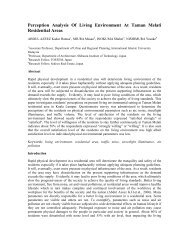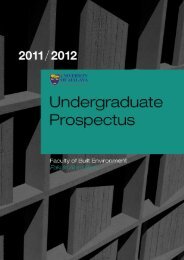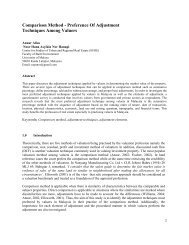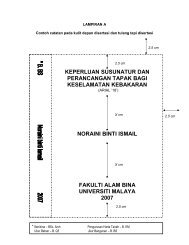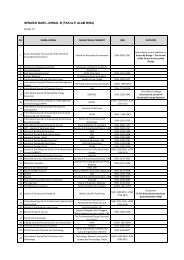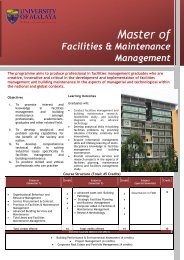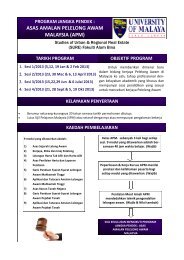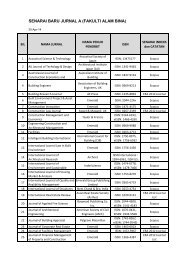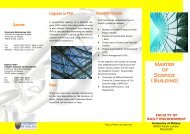Bachelor of Quantity Surveying - Faculty of Built Environment
Bachelor of Quantity Surveying - Faculty of Built Environment
Bachelor of Quantity Surveying - Faculty of Built Environment
Create successful ePaper yourself
Turn your PDF publications into a flip-book with our unique Google optimized e-Paper software.
<strong>Faculty</strong> <strong>of</strong> <strong>Built</strong> <strong>Environment</strong> > Undergraduate Prospectus > 11<br />
BQES 1104<br />
3 credits<br />
CONSTRUCTION ECONOMICS I<br />
Synopsis <strong>of</strong> Course Contents<br />
This course covers the introduction <strong>of</strong> micro and macroeconomics. The introduction to the nature <strong>of</strong> the<br />
construction economics discuss some basic concepts in economics that explained the nature <strong>of</strong><br />
construction industry and <strong>of</strong> construction markets, types <strong>of</strong> cost, price, pr<strong>of</strong>it, marginal analysis and,<br />
demand and supply. The relationships <strong>of</strong> the construction industry to the economy discuss the<br />
interaction with the economy and construction industry as a regulator <strong>of</strong> the economy. This course<br />
also includes a broad understanding <strong>of</strong> the development process and parties involved in construction<br />
industry, cost <strong>of</strong> building, value for money, design evaluation and buildability. It also covers the theory <strong>of</strong><br />
construction firm, procurement and tendering for construction project, its contractual liabilities and<br />
financial implication on client’s firm.<br />
Learning Outcomes<br />
At the end <strong>of</strong> the course, students are able to:<br />
1. identify the basic knowledge <strong>of</strong> micro and macroeconomics;<br />
2. explain the relationship between construction industry and the economy;<br />
3. describe the basic principles <strong>of</strong> construction economics; and<br />
4. apply knowledge <strong>of</strong> economic theory to the construction industry.<br />
Assessment:<br />
Continuous Assessment 30%<br />
Final Examination 70%<br />
S<strong>of</strong>t Skills:<br />
CS1, CT1, CT2, CT3, CT4, TS1, LL1, LL2, KK1, EM1, EM2<br />
BQES 1105<br />
2 credits<br />
DATA ANALYSIS<br />
Synopsis <strong>of</strong> Course Contents<br />
This course delivers the methodological and technical knowledge <strong>of</strong> a wide range <strong>of</strong> analytical<br />
methods used in data analysis. It provides the logical thinking and analysis <strong>of</strong> data in various forms and<br />
using a variety <strong>of</strong> qualitative and quantitative tools and techniques. The tools and techniques in this<br />
course includes methods <strong>of</strong> grouping, structuring, sampling and presentation <strong>of</strong> data, tabling, frequency<br />
distribution, graphical representation, measures <strong>of</strong> location and deviation, ratio, percentage analysis and<br />
probability theories.<br />
Learning Outcomes<br />
At the end <strong>of</strong> the course, students are able to:<br />
1. identify and describe the knowledge on theories, principles and concepts <strong>of</strong> the statistical methods,<br />
covering the use <strong>of</strong> quantitative and qualitative data analysis;<br />
2. analyse and evaluate problems related to the use <strong>of</strong> data analysis in the context <strong>of</strong> construction<br />
industry; and<br />
3. evaluate strategic choices in arriving a decision that are logical and pr<strong>of</strong>essionally.<br />
Assessment:<br />
Continuous Assessment 30%<br />
Final Examination 70%<br />
S<strong>of</strong>t Skills:<br />
CS1, CS2, CT1, CT2, CT3, CT4, CT5, CT6, TS1, TS2, LL1



